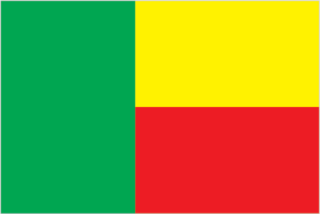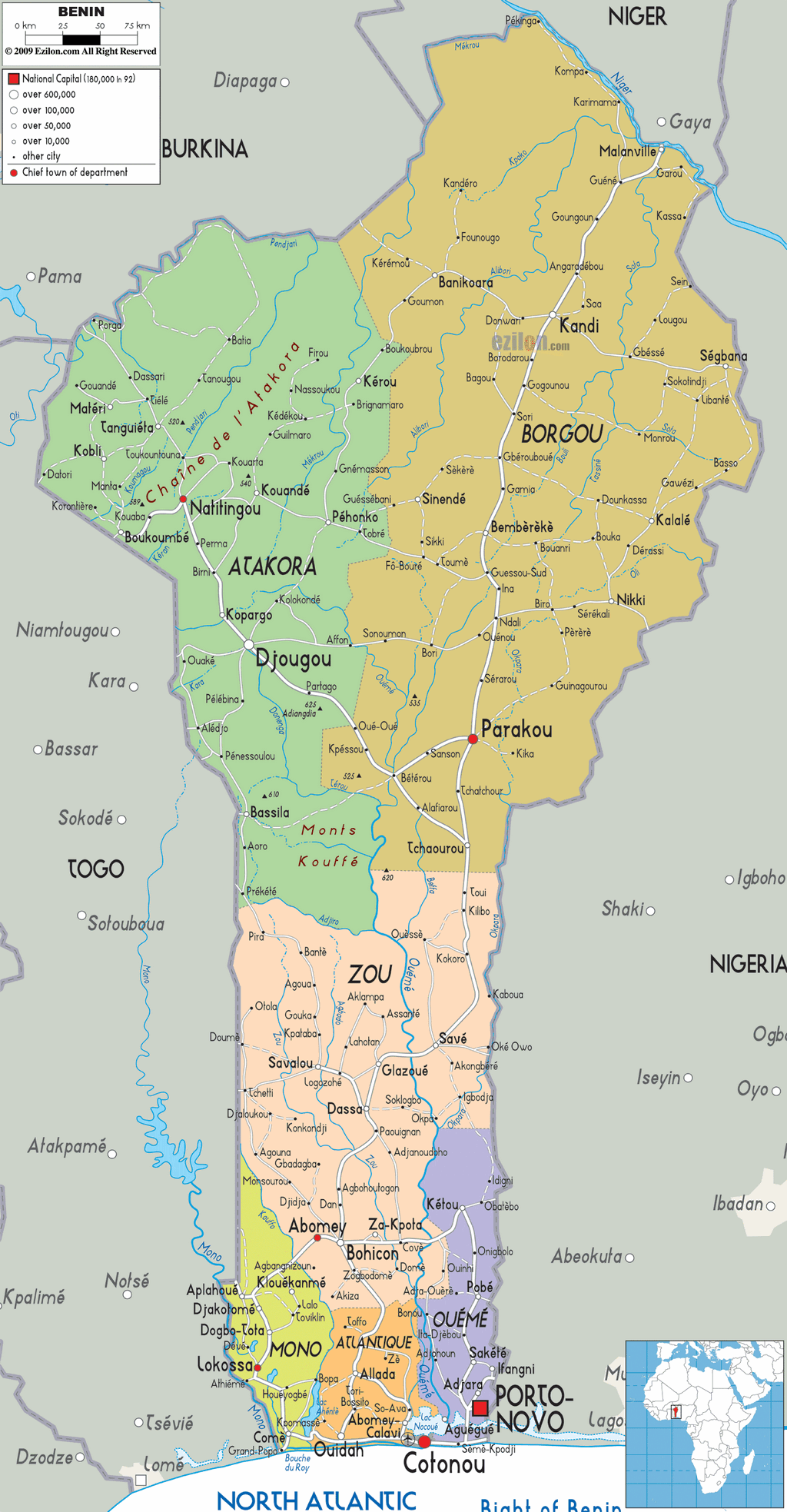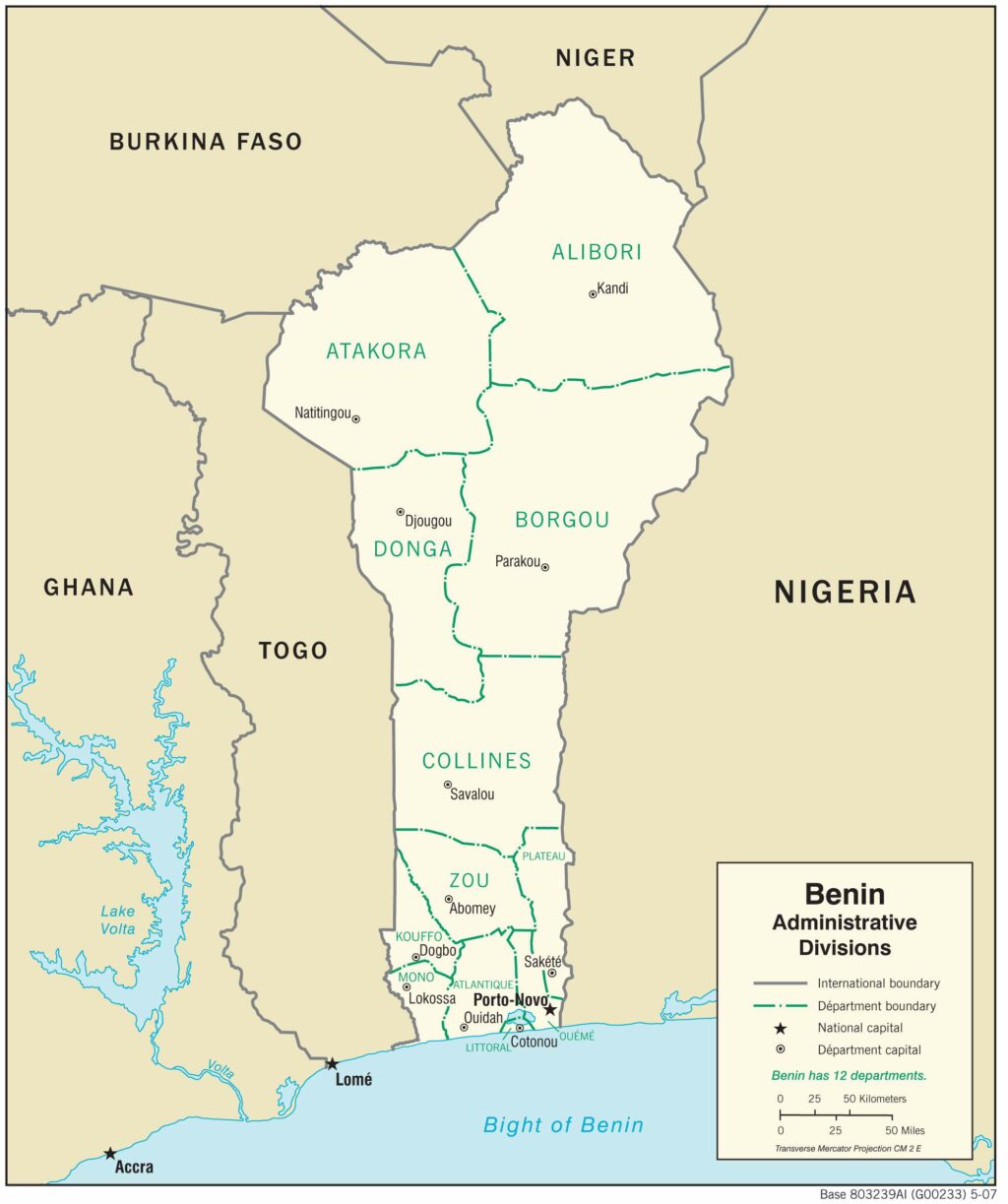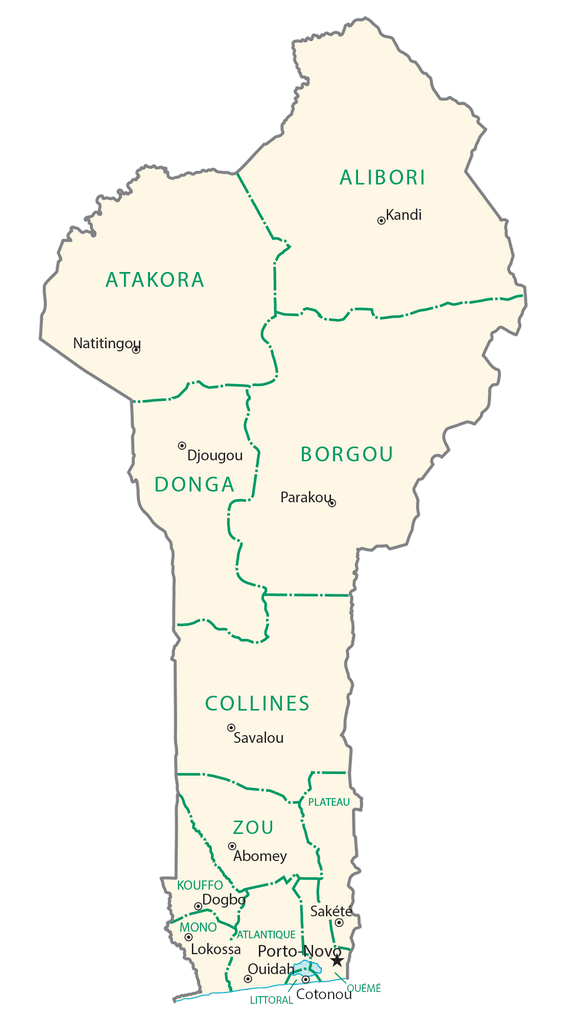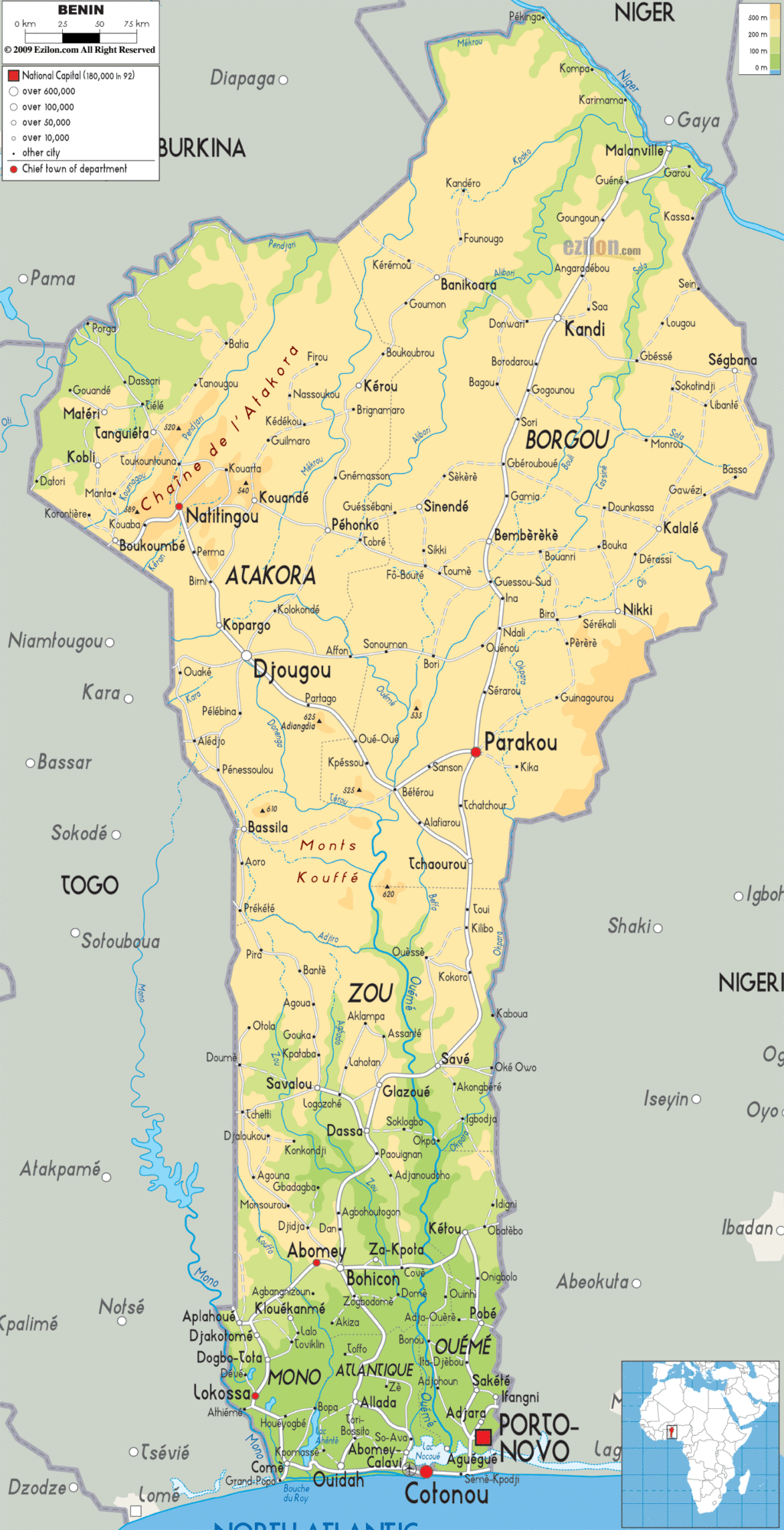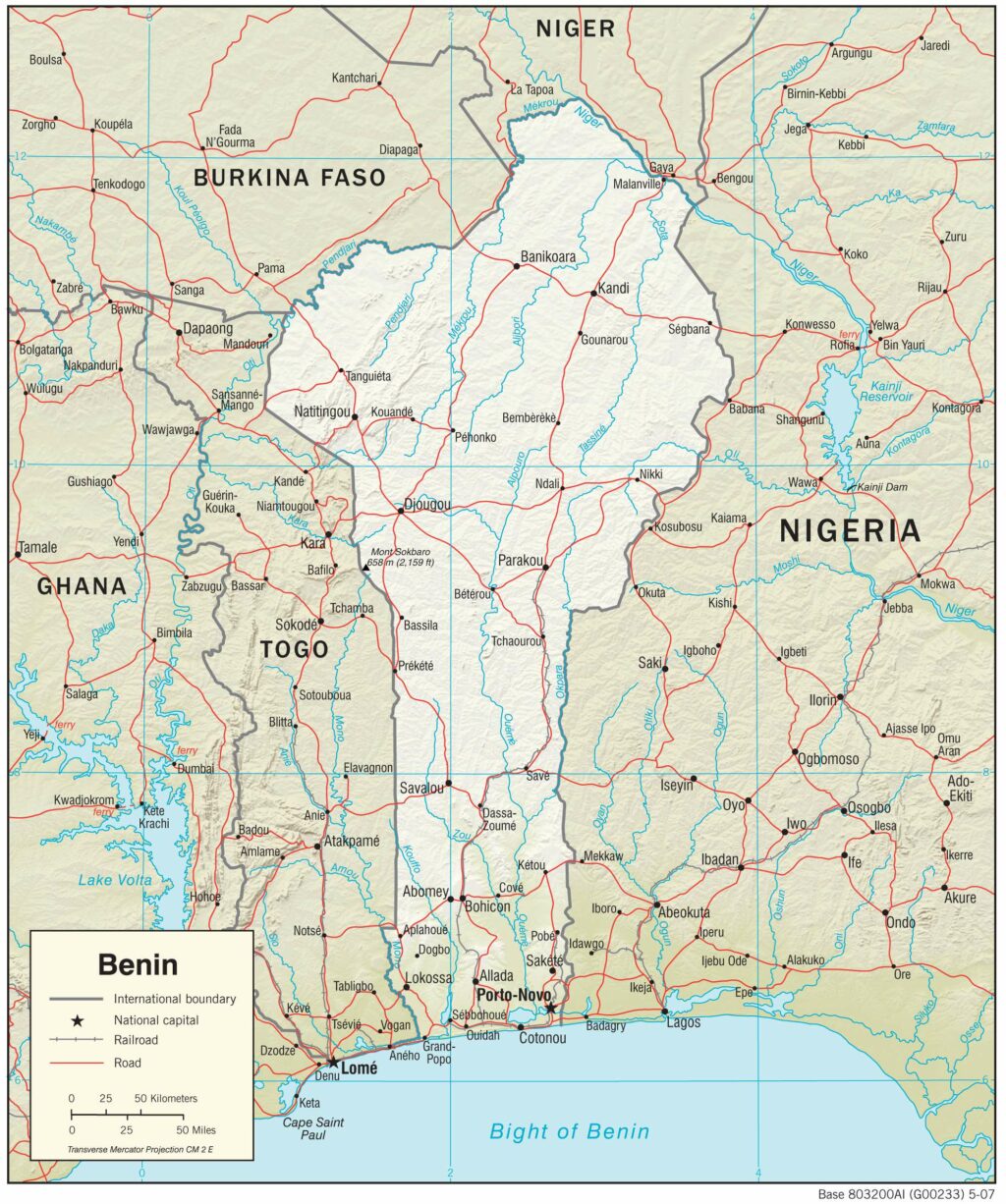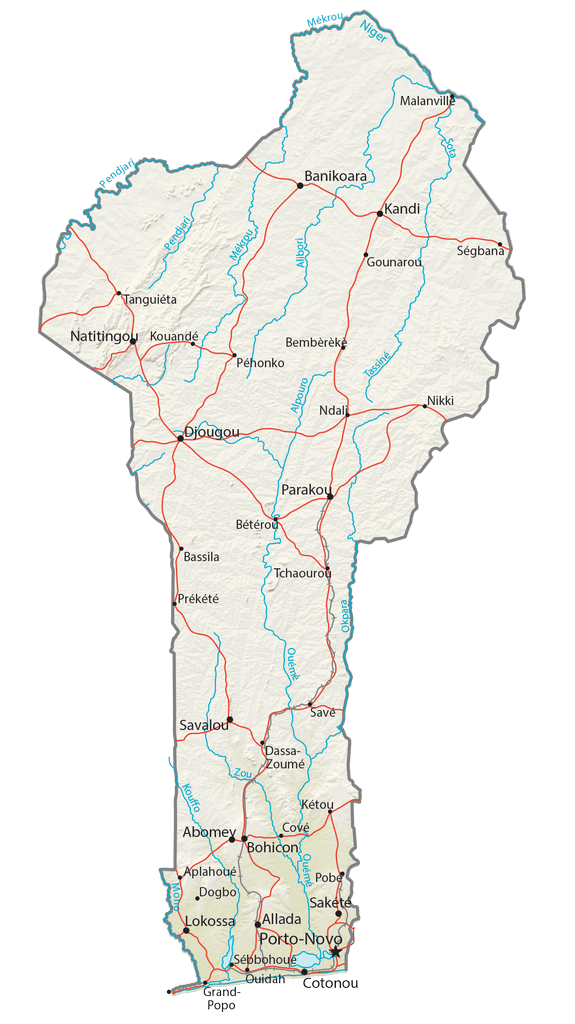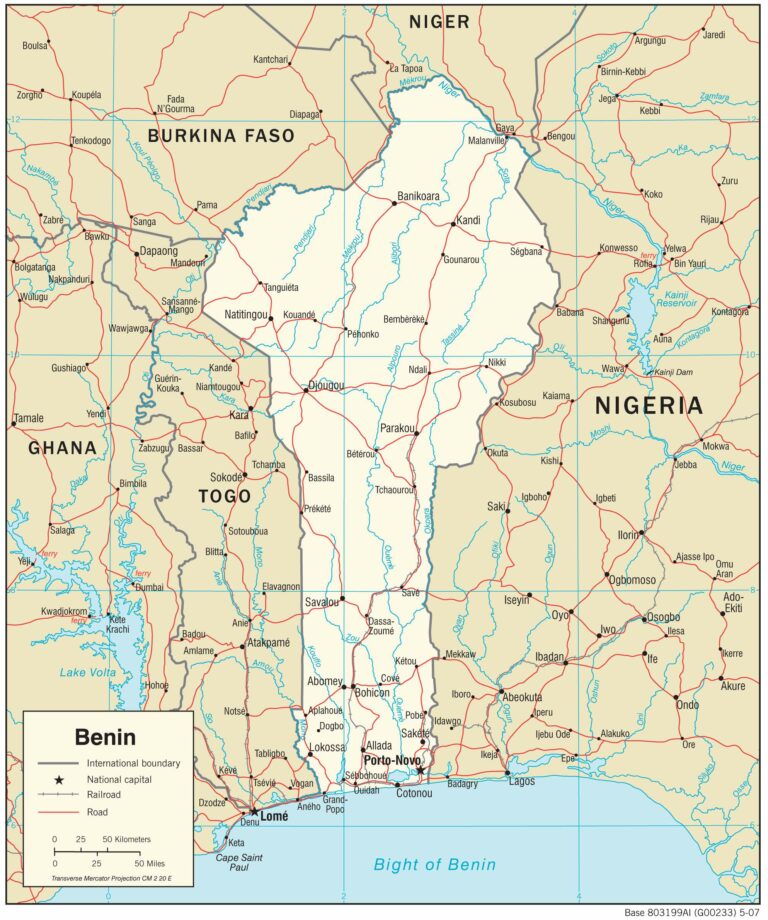Benin is a country in West Africa that encompasses an area of 112,622 sq. km. It has a coastline of 121 km on the Atlantic Ocean to the south.
There is not much variation in elevation in Benin with the average elevation being 200m. The landscape transitions from a narrow and somewhat sandy coastal area to a marshy land with lagoons that rise into the La Terre de Barre Plateau. The wooded savannah of the plateau continues on into the foothills of the Atakora Mountains of the northwest, a branch of the Togo Mountains.
Benin’s highest point is Mt. Sokbaro, which rises 658 m. It has been marked on the map by a yellow upright triangle. The lowest point of the country is the Atlantic Ocean at 0 m.
From the mountainous northwest, the land slopes down into a broad plain and on to the Niger River valley of the far northeast. The Niger and Ouémé are the country’s major rivers.
Explore Benin with this useful map! From major cities and towns to roads and rivers, this map showcases the natural and man-made features of the country. See the forests and topography with the satellite and physical map, and view the administrative units with the department map.
Online Interactive Political Map
Click on ![]() to view map in "full screen" mode.
to view map in "full screen" mode.
Benin has 12 departments which are divided into 77 communes which are further subdivided into arrondissements.
The 12 departments in alphabetical order are: Alibori, Atacora, Atlantique, Borgou, Collines, Couffo, Donga, Littoral, Mono, Oueme, Plateau, and Zou.
With an area of 26,242 sq. km, Alibori is the largest department by area and Atlantique is the most populous one.
Porto-Novo, the national capital of Benin, is located in the Ouémé Department.
Location Maps
Where is Benin?
Benin is located in Western Africa, along the Gulf of Guinea to the south. It borders four other African countries – Nigeria to the east, Togo to the west, Burkina Faso to the northwest, and Niger to the northeast. The Bight of Benin is home to several large cities, the largest of which is Cotonou, the seat of government. However, Porto-Novo is Benin’s capital, located in the southern region of the country.
High Definition Political Map of Benin

Benin Administrative Map
History
Pre-colonial
Prior to 1600, present-day Benin comprised a variety of areas with different political systems and ethnicities. These included city-states along the coast (primarily of the Aja ethnic group, and also including Yoruba and Gbe peoples) and tribal regions inland (composed of Bariba, Mahi, Gedevi, and Kabye peoples). The Oyo Empire, located primarily to the east of Benin, was a military force in the region, conducting raids and exacting tribute from the coastal kingdoms and tribal regions. The situation changed in the 17th and 18th centuries as the Kingdom of Dahomey, consisting mostly of Fon people, was founded on the Abomey plateau and began taking over areas along the coast. By 1727, King Agaja of the Kingdom of Dahomey had conquered the coastal cities of Allada and Whydah. Dahomey had become a tributary of the Oyo Empire, and rivaled but did not directly attack the Oyo-allied city-state of Porto-Novo. The rise of Dahomey, its rivalry with Porto-Novo, and tribal politics in the northern region persisted into the colonial and post-colonial periods.
In the Dahomey, some younger people were apprenticed to older soldiers and taught the kingdom’s military customs until they were old enough to join the army. Dahomey instituted an elite female soldier corps variously called Ahosi (the king’s wives), Mino (“our mothers” in Fongbe), or the “Dahomean Amazons”. This emphasis on military preparation and achievement earned Dahomey the nickname of “Black Sparta”, from European observers and 19th-century explorers such as Sir Richard Burton.
The kings of Dahomey sold their war captives into transatlantic slavery or killed them ritually in a ceremony known as the Annual Customs. By about 1750, the King of Dahomey was earning an estimated £250,000 per year by selling African captives to European slave-traders. The area was named the “Slave Coast” because of a flourishing slave trade. Court protocols which demanded that a portion of war captives from the kingdom’s battles be decapitated, decreased the number of enslaved people exported from the area. The number went from 102,000 people per decade in the 1780s to 24,000 per decade by the 1860s. The decline was partly due to the Slave Trade Act 1807 banning the trans-Atlantic slave trade by Britain in 1808, followed by other countries. This decline continued until 1885 when the last slave ship departed the modern Benin Republic for Brazil, which had yet to abolish slavery. The capital Porto-Novo (“New Port” in Portuguese) was originally developed as a port for the slave trade.
Among the goods the Portuguese sought were carved items of ivory made by Benin’s artisans in the form of carved saltcellars, spoons, and hunting horns – pieces of African art produced for sale abroad as exotic objects.
Colonial
By the middle of the 19th century, Dahomey had “begun to weaken and lose its status as the regional power”. The French took over the area in 1892. In 1899, the French included the land called French Dahomey within the larger French West Africa colonial region.
France sought to benefit from Dahomey and the region “appeared to lack the necessary agricultural or mineral resources for large-scale capitalist development”. As a result, France treated Dahomey as a sort of preserve in case future discoveries revealed resources worth developing.
The French government outlawed the capture and sale of slaves. Previous slaveowners sought to redefine their control over slaves as control over land, tenants, and lineage members. This provoked a struggle among Dahomeans, “concentrated in the period from 1895 to 1920, for the redistribution of control over land and labor. Villages sought to redefine boundaries of lands and fishing preserves. Religious disputes scarcely veiled the factional struggles over control of land and commerce which underlay them. Factions struggled for the leadership of great families”.
In 1958, France granted autonomy to the Republic of Dahomey, and full independence on 1 August 1960 which is celebrated each year as Independence Day, a national holiday. The president who led the country to independence was Hubert Maga.
Post-colonial
After 1960, there were coups and regime changes, with the figures of Hubert Maga, Sourou Apithy, Justin Ahomadégbé, and Émile Derlin Zinsou dominating; the first 3 each represented a different area and ethnicity of the country. These 3 agreed to form a Presidential Council after violence marred the 1970 elections.
On 7 May 1972, Maga ceded power to Ahomadégbé. On 26 October 1972, Lt. Col. Mathieu Kérékou overthrew the ruling triumvirate, becoming president and stating that the country would not “burden itself by copying foreign ideology, and wants neither Capitalism, Communism, nor Socialism”. On 30 November 1974, he announced that the country was officially Marxist, under control of the Military Council of the Revolution (CMR), which nationalized the petroleum industry and banks. On 30 November 1975, he renamed the country the People’s Republic of Benin. The regime of the People’s Republic of Benin underwent changes over the course of its existence: a nationalist period (1972–1974); a socialist phase (1974–1982); and a phase involving an opening to Western countries and economic liberalism (1982–1990).
In 1974, under the influence of young revolutionaries – the “Ligueurs” – the government embarked on a socialist program: nationalization of strategic sectors of the economy, reform of the education system, establishment of agricultural cooperatives and new local government structures, and a campaign to eradicate “feudal forces” including tribalism. The regime banned opposition activities. Mathieu Kérékou was elected president by the National Revolutionary Assembly in 1980, re-elected in 1984. Establishing relations with China, North Korea, and Libya, he put “nearly all” businesses and economic activities under state control, causing foreign investment in Benin to dry up. Kérékou attempted to reorganize education, pushing his own aphorisms such as “Poverty is not a fatality”. The regime financed itself by contracting to take nuclear waste, first from the Soviet Union and later from France.
In the 1980s, Benin experienced higher economic growth rates (15.6% in 1982, 4.6% in 1983 and 8.2% in 1984), until the closure of the Nigerian border with Benin led to a drop in customs and tax revenues. The government was no longer able to pay civil servants’ salaries. In 1989, riots broke out when the regime did not have enough money to pay its army. The banking system collapsed. Eventually, Kérékou renounced Marxism, and a convention forced Kérékou to release political prisoners and arrange elections. Marxism–Leninism was abolished as the nation’s form of government.
The country’s name was officially changed to the Republic of Benin on 1 March 1990, after the newly formed government’s constitution was completed.
Kérékou lost to Nicéphore Soglo in a 1991 election and became the first President on the African mainland to lose power through an election. Kérékou returned to power after winning the 1996 vote. In 2001, an election resulted in Kérékou winning another term, after which his opponents claimed election irregularities. In 1999, Kérékou issued a national apology for the substantial role that Africans had played in the Atlantic slave trade.
Kérékou and former president Soglo did not run in the 2006 elections, as both were barred by the constitution’s restrictions on age and total terms of candidates. On 5 March 2006, an election resulted in a runoff between Yayi Boni and Adrien Houngbédji. The runoff election was held on 19 March and was won by Boni, who assumed office on 6 April. Boni was reelected in 2011, taking 53.18% of the vote in the first round—enough to avoid a runoff election. He was the first president to win an election without a runoff since the restoration of democracy in 1991.
In the March 2016 presidential elections in which Boni Yayi was barred by the constitution from running for a third term, businessman Patrice Talon won the second round with 65.37% of the vote, defeating investment banker and former Prime Minister Lionel Zinsou. Talon was sworn in on 6 April 2016. Speaking on the same day that the Constitutional Court confirmed the results, Talon said that he would “first and foremost tackle constitutional reform”, discussing his plan to limit presidents to a single term of 5 years in order to combat “complacency”. He said that he planned to slash the size of the government from 28 to 16 members. In April 2021, President Patrice Talon was re-elected, with more than 86.3% of the votes cast, in Benin’s presidential election. The change in election laws resulted in total control of parliament by president Talon’s supporters.
In February 2022, Benin saw its largest terrorist attack in history.
On 20 February 2022, President Patrice Talon inaugurated an exhibition with 26 pieces of sacred art returned to Benin by France, 129 years after they were looted by colonial forces.
Physical Map of Benin

Geography
The north–south strip of land in West Africa lies between latitudes 6° and 13°N, and longitudes 0° and 4°E. It is bounded by Togo to the west, Burkina Faso and Niger to the north, Nigeria to the east, and the Bight of Benin to the south. The distance from the Niger River in the north to the Atlantic Ocean in the south is about 650 km (404 mi). Although the coastline measures 121 km (75 mi), the country measures about 325 km (202 mi) at its widest point. 4 terrestrial ecoregions lie within Benin’s borders: Eastern Guinean forests, Nigerian lowland forests, Guinean forest-savanna mosaic, and West Sudanian savanna. It had a 2018 Forest Landscape Integrity Index mean score of 5.86/10, ranking it 93rd globally out of 172 countries.
Benin shows some variation in elevation and can be divided into 4 areas from the south to the north, starting with the lower-lying, sandy, coastal plain (highest elevation 10 m (32.8 ft)) which is, at most, 10 km (6.2 mi) wide. It is marshy and dotted with lakes and lagoons communicating with the ocean. Behind the coast lies the Guinean forest-savanna mosaic-covered plateaus of southern Benin (altitude between 20 and 200 m (66 and 656 ft)), which are split by valleys running north to south along the Couffo, Zou, and Ouémé Rivers.
This geography makes it vulnerable to climate change. With the majority of the country living near the coast in lower-lying areas sea level rise could have effects on the economy and population. Northern areas will see additional regions become deserts. An area of flatter land dotted with rocky hills whose altitude reaches 400 m (1,312 ft) extends around Nikki and Save.
A range of mountains extends along the northwest border and into Togo; these are the Atacora. The highest point, Mont Sokbaro, is at 658 m (2,159 ft). Benin has fields, mangroves, and remnants of forests. In the rest of the country, the savanna is covered with thorny scrub and dotted with baobab trees. Some forests line the banks of rivers. In the north and the northwest of Benin, the Reserve du W du Niger and Pendjari National Park has elephants, lions, antelopes, hippos, and monkeys. Pendjari National Park together with the bordering Parks Arli and W in Burkina Faso and Niger are among the strongholds for the endangered West African lion. With an estimated 356 (range: 246–466) lions, W-Arli-Pendjari harbors the largest remaining population of lions in West Africa. Historically Benin has served as habitat for the endangered painted hunting dog, Lycaon pictus; this canid is thought to have been locally extirpated.
Annual rainfall in the coastal area averages 1300 mm or about 51 inches. Benin has 2 rainy and 2 dry seasons per year. The principal rainy season is from April to late July, with a shorter less intense rainy period from September to November. The main dry season is from December to April, with a cooler dry season from July to September. Temperatures and humidity are higher along the tropical coast. In Cotonou, the average maximum temperature is 31 °C (87.8 °F); the minimum is 24 °C (75.2 °F).
Variations in temperature increase when moving north through savanna and plateau toward the Sahel. A dry wind from the Sahara called the Harmattan blows from December to March, when grass dries up, other vegetation turns reddish brown, and a veil of fine dust hangs over the country, causing the skies to be “overcast”. It is also the season when farmers burn brush in the fields.
